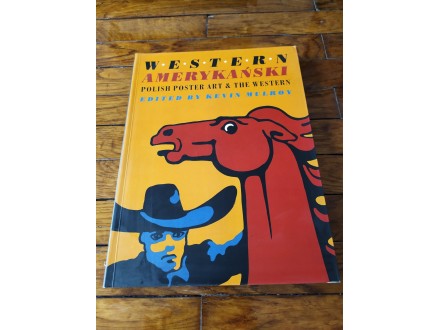Western Amerykanski: Polish Poster Art and the Western
| Cena: |
| Želi ovaj predmet: | 3 |
| Stanje: | Nekorišćen |
| Garancija: | Ne |
| Isporuka: | Pošta Post Express Lično preuzimanje |
| Plaćanje: | Tekući račun (pre slanja)
Lično |
| Grad: |
Beograd-Zemun, Beograd-Zemun |
ISBN: Ostalo
Godina izdanja: 1999
Jezik: Engleski
Oblast: Film
Autor: Strani
Western Amerykanski: Polish Poster Art and the Western Paperback – November 1, 1999
by Kevin Mulroy (Editor)
The figure of Gary Cooper as the proud frontier sheriff striding down the street in the 1952 American Western High Noon is as much a symbol of dignity and courage in contemporary Poland as it is in the United States. In 1989, for Poland’s first free election since the Communist takeover, the political party Solidarity dramatically and successfully used that image of Cooper on a campaign poster urging voters to respond to their country’s own “high noon”―their critical moment of decision.
The Western motion picture, from its silent days on, exported an epic vision of America. William S. Hart, John Wayne, James Stewart, Henry Fonda, Gregory Peck, Clint Eastwood, and Kirk Douglas became legendary heroes throughout the world, and especially in Poland.
In postwar Poland, film poster artists employed the universally recognized symbols of the Western―horse, six-shooter, boots, tin-star badge, Stetson, saddle―to convey violence as a negative force. Unlike many other art forms, the film poster did not fall within the censor’s domain because it was not expected to pose a threat to the social order. But messages were conveyed through subtle means of symbol and color. The Polish poster has been likened to the Trojan horse, with the artist smuggling messages onto the streets in the guise of ephemera.
The posters displayed so strikingly in this book, and discussed in three essays, are from the golden age of Polish poster-making, the mid-1940s to the 1970s. They are part of the collection assembled by the Autry Museum of Western Heritage, the Western poster holdings of which include more than a hundred created in Poland―the largest such collection outside of Poland itself.
1. Lično preuzimanje je moguće uz prethodni dogovor. Potrebno je da ponesete tačan iznos.
2. Za uplate na račun knjiga se šalje kao CC paket redovnom poštom ili Post Expressom. Uslugu slanja nije uracunata u cenu. Troškove poštarine snosi kupac prema zvaničnom cenovniku PTT Srbije.
https://www.posta.rs/cir/alati/KalkulatorCena.aspx?vrPos=pismonosneSrb
3. Knjige ne šaljem u inostranstvo osim ako pre kupovine nije tako dogovoreno.
Predmet: 58286791







